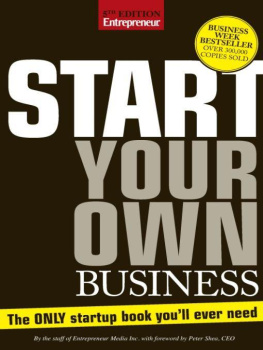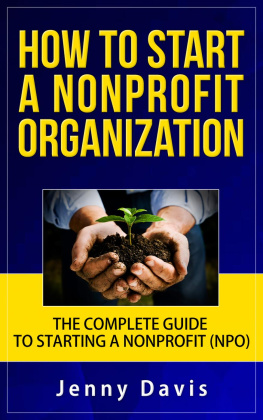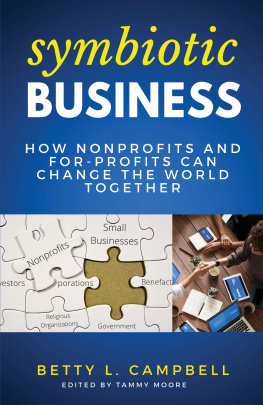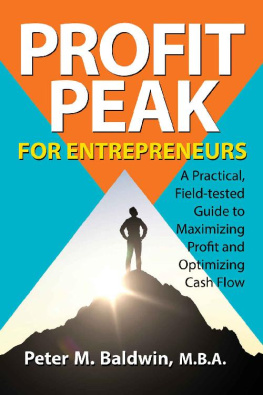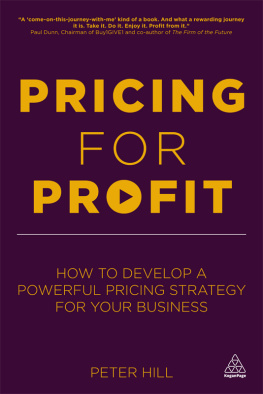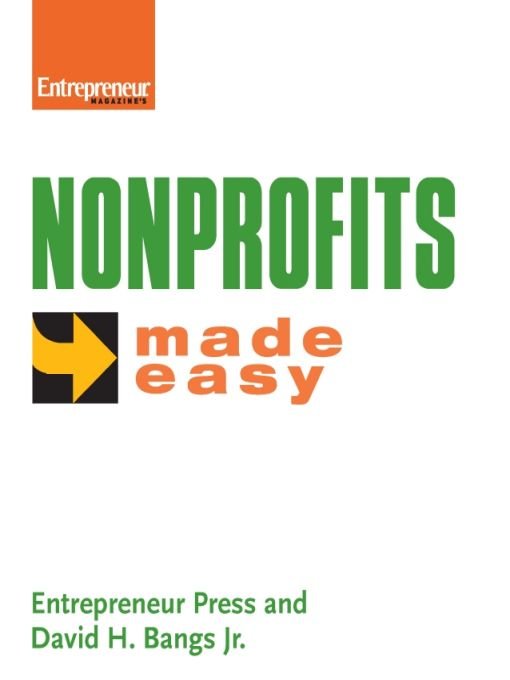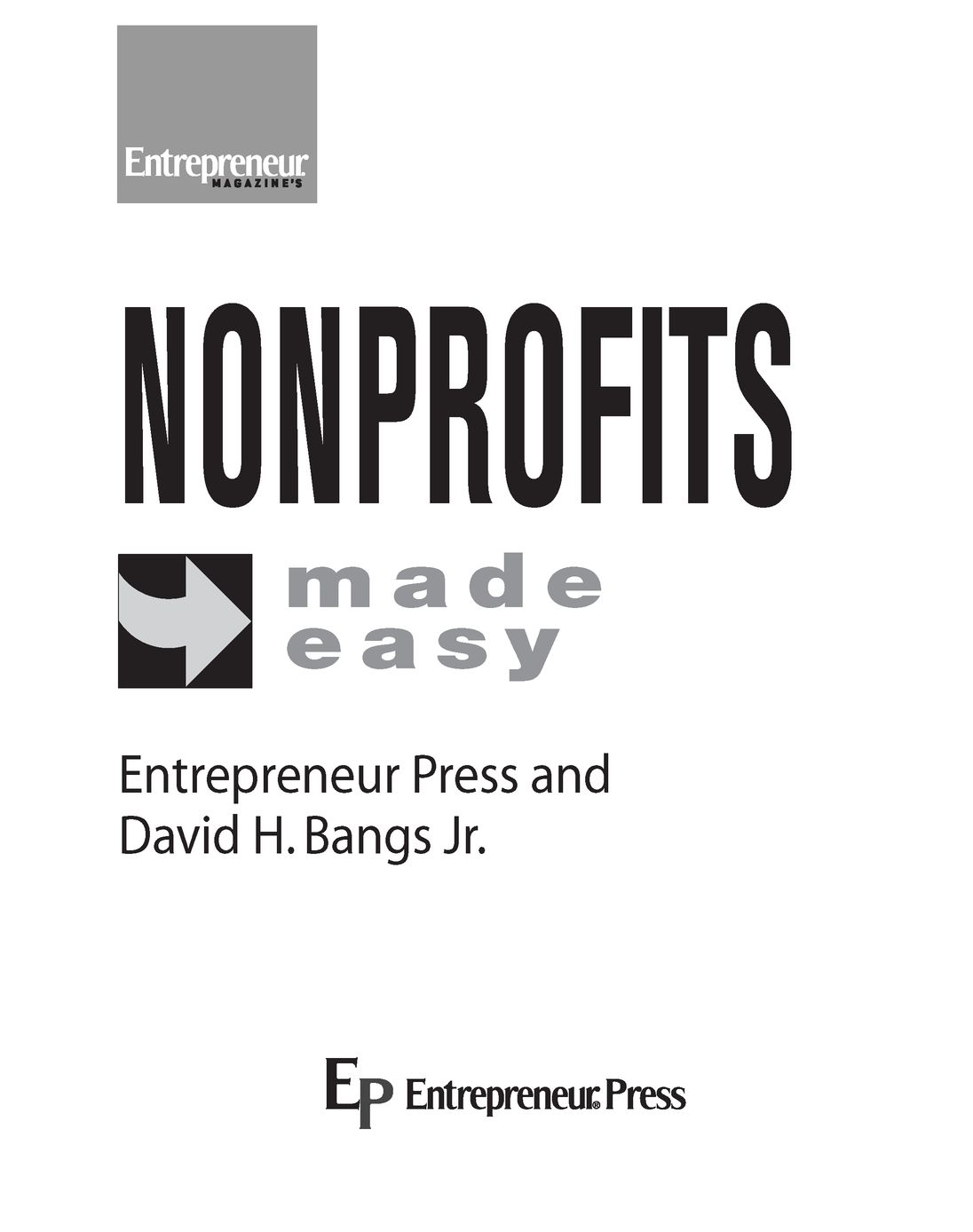Table of Contents
Additional Titles in Entrepreneurs Made Easy Series
Accounting and Finance for Small Business Made Easy: Secrets You Wish Your CPA Had Told You by Robert Low
Business Plans Made Easy: Its Not as Hard as You Think by Mark Henricks
Meetings Made Easy: The Ultimate Fix-It Guide by Frances Micale
Strategic Planning Made Easy by Fred L. Fry, Charles R. Stoner, and Laurence G. Weinzimmer
Advertising Without an Agency Made Easy by Kathy J. Kobliski
Managing a Small Business Made Easy by Martin E. Davis
Mastering Business Growth and Change Made Easy by Jeffrey A. Hansen
Financing Your Business Made Easy by Ralph Alterowitz and Jon Zonderman
Project Management Made Easy by Sid Kemp
Marketing Made Easy by Kevin Epstein
Customer Service Made Easy by Paul Levesque
Business Models Made Easy by Don Debelak
Foreword
WHEN I FIRST MET DAVID (ANDY) BANGS IN 1999, I WAS THE Executive Director of a lean, two-person arts organization. He was a consultant hired to help us develop our first-ever business plan. The organization had a dedicated but small board of directors, and we were overwhelmed with requests for programs. It was clear we needed to recruit additional board members and hire staff, but we were stuck in a six-month planning cycle that endangered our growth.
Andy helped us define our understanding of constituencies and competition as well as help us develop cost analyses and cash flow projections in order to develop a three-year business plan that included realistic operational goals. Having a clearly articulated plan in place made it easier for us to recruit talented staff and new board members with appropriate skill sets. It was then possible to keep everyone focused and moving forward.
As you will read in Nonprofits Made Easy, starting and sustaining a nonprofit requires a dedicated team invested in the organization. Successful nonprofits have the systems to support long-term planning and adequate evaluation of progress against agreed-upon benchmarks. As you grow, this allows staff, board, and volunteers working together to reach goals and celebrate the small victories along the way. The organizations that survive and thrive are the ones that catch mistakes early, seek advice and solutions, and change course swiftly.
We have been using Andys books for years now and appreciate his ability to break down what could be a daunting task into manageable components, as he does in Nonprofits Made Easy. The nonprofit sector is fortunate to have this book available. A strong team of people armed with a clear vision and the appropriate tools can, in fact, make creating and sustaining a successful organization look easy. Good luck with your venture, have fun, and remember to celebrate the successes!
Cynthia Billings
Executive Director of PlusTime NH
Chichester, NH
Janice Hastings
Consultant to PlusTime NH
former Executive Director of VSA Arts
New Hampshire
former Director of Affiliate and Education
Services for VSA Arts, Washington, DC
Introduction
IN 1999 THE NEW HAMPSHIRE CHARITABLE FOUNDATION (NHCF) SELECTED four nonprofit organizations to participate in the Entrepreneurial Investing (EI) program. Among the selection criteria were that the nonprofits must:
Have strong, well-established executive directors;
Have potential for the organization to grow statewide;
Have a history of achievement;
Be small enough for a grant promising $30,000 to $35,000 a year for three years to make a big difference.
Two very small organizations (PlusTime NH and VSA Arts NH) were selected. As it turned out, they benefited more from the program than the two larger organizations (MicroCredit and Bancroft Industries), perhaps because they were smaller and newer. These four organizations were chosen from over 70 applicants and committed themselves to a close relationship with NHCF. As Pat Vasbinder, the COO of NHCF, put it, the foundation staff would become their new best friends.
Why was EI created? Major funders have been looking for precise outcomes from nonprofits. Goals of making the community better or helping the poor feed themselves, while worthy, have to be expressed as objective outcomes so that progress can be measured. Business owners new to philanthropy have begun to ask for the same kind of accountability as they face in their businesses: financial goals, business plans, and measurable achievements. Hard numbers rather than soft goals are now mandatory. Many nonprofits are at a loss as to how to meet these new challenges.
EI had five aims. The first was to build capacity in these organizations (provide new skills, access to NHCFs wide range of experience, spot funding for needed consultants, and so forth). The second aim was to help develop a peer group of executive directors (EDs) so they could pool their skills. (This turned out to be one of the most valuable results of EI.) Third was to help the nonprofits to learn how to talk business. If business owners are the funders of the future, the EDs have to be able to talk with the owners in terms the owners understand. Fourth, all small nonprofits have to widen their funding base, not just rely on the same few sources. In some cases this means that they have to develop a business that helps fund the organization. Finally, the fifth aim was to help the selected nonprofits make a change in the entire state, not just in a small local area.
To achieve these five aims, Pat and the NHCF staff decided to start EI with a six-month business planning program. I was hired to teach business planning to the four executive directors and whomever they chose to join themboard members, trusted staff, and in one case a friend.
The program was a revelation to all concerned. I gained a new and deeper appreciation of the difficulties the EDs face on a daily basis. Their ability to improvise and make do with limited resources impressed me. Their eagerness to pick up new skills (notably cash flow budgeting and strategic planning) delighted me. No teacher ever has had such eager students.
The people from PlusTime and VSA Arts were the most eager learners, perhaps because they had the most to learn. The idea that they could take control of their future rather than react to whatever grant opportunities presented themselves was a new one: the old habits made looking ahead almost impossible. Janice Hastings, then the head of VSA Arts NH, took to the rigors of financial management as fast as anyone Ive met in 30 years of preaching cash flow and budgeting. Cynthia Billings, the ED of PlusTime, involved her board from the beginning and, as a result, was able to put her organization on a firm financial footing for the first time.
Id be hard pressed to pick one over the other. The proof is in the progress their organizations made. Both of them quickly grew to statewide and both became models for similar organizations on a national level. Janice now spreads the planning gospel through VSA National, helping VSA affiliates in many states experience the joys of unit cost analysis. Cynthia has become a national power in the after-school movement. Could they have done this without EI? Of course. But they probably would not have done so well so quickly without it.


